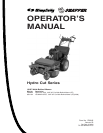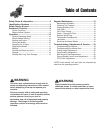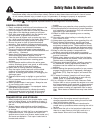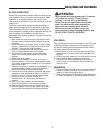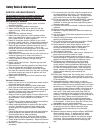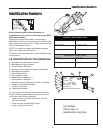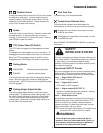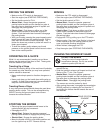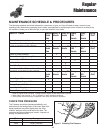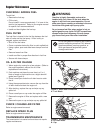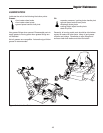
2
GENERAL OPERATION
1. Read, understand, and follow all instructions on the
machine and in the manual(s) before starting.
2. Do not put hands or feet near or under the machine.
Keep clear of the discharge opening at all times.
3. Only allow responsible adults, who are familiar with
the instructions, to operate this machine.
4. Clear the area of objects such as rocks,wire, toys,
etc., which could be thrown by the blade. Stay behind
the handle when the engine (motor) is running.
5. Be sure the area is clear of bystanders before
operating. Stop machine if anyone enters the area.
6. Do not operate machine barefooted or while wearing
sandals. Always wear substantial footwear.
7. Do not pull machine backward unless absolutely
necessary. Always look down and behind before and
while moving backward.
8. Never direct discharged material toward anyone.
Avoid discharging material against a wall or
obstruction. Material may ricochet back toward the
operator. Stop the blade when crossing gravel
surfaces.
9. Do not operate machine without the entire grass
catcher, discharge guard, rear guard, or other safety
protective devices in place and working.
10. Never leave a running machine unattended.
11. Stop the engine (motor) and wait until the blade
comes to a complete stop before cleaning the
machine, removing grass catcher, or unclogging the
discharge guard.
12. Operate machine only in daylight or good artificial
light.
13. Do not operate machine while under the influence of
alcohol or drugs.
14. Never operate mower in wet grass. Always be sure
of your footing; walk; never run.
15. Disengage the drive system, if so equipped, before
starting the engine (motor).
16. If the machine should start to vibrate abnormally,
stop the engine (motor) and check for the cause
immediately. Vibration is generally a warning of
trouble.
17. Always wear eye protection when operating machine.
18. See manufacturer’s instructions for proper operation
and installation of accessories. Only use accessories
approved by the manufacturer.
19 Watch for traffic when operating near or crossing
roadways.
20. Use extra care when loading or unloading the unit
into a trailer or truck.
21. Always wear eye protection when operating this unit.
22. Data indicates that operators, age 60 years and
above, are involved in a large percentage of power
equipment-related injuries. These operators should
evaluate their ability to operate the equipment safely
enough to protect themselves and others from injury.
23. Keep in mind the operator is responsible for
accidents occurring to other people or property.
24. All drivers should seek and obtain professional and
practical instruction.
25. Before using, always visually check that the blades
and blade hardware are present, intact, and secure.
Replace worn or damaged parts.
26. Disengage attachments before: refueling, removing
an attachment, making adjustments (unless the
adjustment can be made from the operator’s
position).
27. Before leaving the operator’s position for any reason,
engage the parking brake (if equipped), disengage
the blades (PTO), stop the engine, and remove the
key.
28. To reduce fire hazard, keep the unit free of grass,
leaves, & excess oil. Do not stop or park over dry
leaves, grass, or combustible materials.
29. It is a violation of California Public Resource Code
Section 4442 to use or operate the engine on or near
any forest-covered, brush-covered, or grass-covered
land unless the exhaust system is equipped with a
spark arrester meeting any applicable local or state
laws. Other states or federal areas may have similar
laws.
TRANSPORTING AND STORAGE
1. When transporting the unit on an open trailer, make
sure it is facing forward, in the direction of travel. If
the unit is facing backwards, wind lift could damage
the unit.
2. Always observe safe refueling and fuel handling
practices when refueling the unit after transportation
or storage.
3. Never store the unit (with fuel) in an enclosed poorly
ventilated structure. Fuel vapors can travel to an
ignition source (such as a furnace, water heater, etc.)
and cause an explosion. Fuel vapor is also toxic to
humans and animals.
4. Always follow the engine manual instructions for
storage preparations before storing the unit for both
short and long term periods.
5. Always follow the engine manual instructions for
proper start-up procedures when returning the unit to
service.
6. Never store the unit or fuel container inside where
there is an open flame or pilot light, such as in a
water heater. Allow unit to cool before storing.
Read these safety rules and follow them closely. Failure to obey these rules could result in loss of control
of unit, severe personal injury or death to you, or bystanders, or damage to property or equipment.
This mo
wing deck is capable of amputating hands and feet and throwing objects.
The triangle in text signifies important cautions or warnings which must be followed.
Safety Rules & Information



